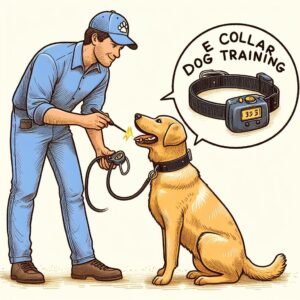Introduction
Are you tired of your dog digging up your garden, barking at every passing squirrel, or pulling on the leash during walks? If so, then it’s time to consider some dog training methods that will transform your furry friend into a well-behaved and obedient companion. Did you know there a many types of dog training? From traditional obedience training to modern positive reinforcement techniques, there are various types of dog training that can help address specific behavioral issues and enhance the bond between you and your canine companion. In this article, we will explore the different approaches to dog training and delve into their effectiveness in shaping your furry friend’s behavior. So buckle up and get ready to discover which type of training will have tails wagging with joy!

Positive Reinforcement Training:
Positive reinforcement training is a highly effective method of training that focuses on rewarding desired behaviors rather than punishing unwanted ones. This approach is based on the belief that animals, including humans, are more likely to repeat behaviors that have positive outcomes. By using rewards such as treats, praise, or play as a motivator, trainers can encourage their pets to learn new skills and modify their behavior.
One of the biggest advantages of positive reinforcement training is its ability to build trust and strengthen the bond between trainer and pet. Through this method, pets not only learn obedience commands but also learn to associate training sessions with positive experiences. This creates a sense of joy and enthusiasm in the animal during each session, making the whole process enjoyable for both trainer and pet.
Clicker Training:
Clicker training is a revolutionary method of teaching dogs that emphasizes positive reinforcement and clear communication. Instead of relying on force or punishment, clicker training uses a small handheld device that makes a distinct clicking sound to mark desired behaviors. This helps the dog understand exactly what they are being rewarded for, leading to faster and more effective learning.
One of the main advantages of clicker training is its versatility. It can be used to teach dogs basic obedience commands such as sit, stay, or come, but it can also be applied to more complex behaviors like retrieving objects or performing tricks. The precision and consistency of the clicker signal make it an excellent tool for shaping behavior step by step. It allows trainers to break down tasks into smaller parts and reward each correct response a
Negative Reinforcement Training:
In this method, undesirable behaviors are corrected by removing an unpleasant stimulus when the dog performs the desired behavior. It involves using pressure or discomfort to prompt the dog to perform the correct action.
Alpha Dog or Dominance Training:
The concept of alpha dog or dominance training has long been a popular approach in dog training circles. This technique centers around establishing the owner as the dominant leader, using physical and verbal corrections to reinforce their authority. While it may seem enticing to adopt such a commanding role with your furry companion, modern research suggests that there might be more efficient approaches to training.
Model-Rival or Mirror Training:
One of the most effective training techniques for dogs is the model-rival or mirror method. This approach involves using a trained dog as a model and let them demonstrate the desired behavior to the untrained dog. The untrained dog then observes the actions of the model and imitates them, learning through observation and imitation.
This technique has been proven to be highly successful in teaching complex tasks and behaviors to dogs. By watching another dog perform a task correctly, they can learn more effectively than through verbal or physical cues from humans alone. It taps into their natural instinct of observing and learning from other pack members.
Relationship-Based Training:
Relationship-based dog training is a method that focuses on building a strong bond between the owner and the dog. It goes beyond teaching basic commands and obedience; it is about understanding the needs, emotions, and behaviors of our furry friends. By developing this deep connection, we are not only able to communicate effectively but also create an environment based on trust and respect.
One key aspect of relationship-based dog training is being mindful of our own behavior as owners. Dogs are highly observant creatures who pick up on our energy, body language, and tone of voice. By being aware of how we interact with them, we can ensure that we are sending clear messages and encouraging positive responses from our dogs.
Behavior Modification Training:
Behavior modification training is a highly effective approach to changing undesirable behaviors in both humans and animals. This type of training focuses on positive reinforcement techniques, such as rewards and praise, to encourage the development of new, desired behaviors. Unlike punishment-based methods that can be harsh and ineffective, behavior modification training emphasizes creating a positive environment that promotes learning and growth.
One of the key principles of behavior modification training is understanding the underlying causes of the unwanted behavior. By identifying the motivators behind these behaviors, trainers can develop strategies to replace them with more appropriate actions. For example, if a dog barks excessively out of boredom or anxiety, providing mental stimulation through puzzle toys or engaging in interactive play sessions can redirect their focus and reduce the need for excessive barking.
Obedience Training:
Obedience dog training is more than just teaching a dog basic commands like sit, stay, and come. It involves building a strong bond between the owner and the pet, instilling discipline and respect in the dog’s behavior. The process requires consistency, patience, and positive reinforcement techniques to achieve desired results.
One fresh perspective on obedience training is that it not only benefits dogs but also enhances the overall well-being of their owners. By learning how to effectively communicate with their pets and establishing clear boundaries, owners experience reduced stress levels and improved confidence in handling their furry companions. Obedience training allows for better control over dogs in public spaces or around other people and animals, creating a harmonious environment for everyone involved.
Agility Training:
Agility dog training is much more than just running through an obstacle course. It requires a deep level of connection and trust between the handler and the dog. In fact, agility training can strengthen the bond between human and canine in ways that traditional obedience training cannot.
One of the most important aspects of agility training is teaching your dog to listen to your cues while navigating obstacles at high speeds. This requires clear communication and precise timing from the handler. It’s not enough to simply give a command; you must be able to anticipate your dog’s movements and guide them through each obstacle with finesse.
Scent Detection Training:
Scent detection dog training is a fascinating and highly specialized area of canine training that involves teaching dogs to identify and locate specific scents. While most people are familiar with the concept of drug-sniffing dogs, scent detection can also be used for a variety of other purposes, including search and rescue operations, detecting bed bugs or termite infestations, and even identifying certain medical conditions.
One important aspect of scent detection dog training is building the dog’s confidence in its ability to find and indicate the presence of the desired scent. By using positive reinforcement techniques such as play or rewards, trainers can encourage dogs to actively seek out and alert their handlers when they detect the target odor. This process helps to develop a strong bond between handler and dog, as well as ensuring accurate scent identification during real-life scenarios.
These are just a few examples of the different types of dog training methods available. The most effective approach may vary depending on the individual dog’s temperament, behavior, and training goals.
Final Thoughts
You now know that you know the types of dog training. It can help you tailor a training method to train your lovable pooch. Positive reinforcement training focuses on rewarding good behavior and building a strong bond between the owner and the dog. On the other hand, aversive training uses punishment to discourage unwanted behavior. It is important for dog owners to choose a method that aligns with their own values and beliefs about animal welfare. No matter the approach, consistency, patience, and understanding are key in achieving successful results. By investing time and effort into proper training techniques, dog owners can create a happy and well-behaved canine companion for life. Start exploring the different types of dog training today and discover the method that best suits you and your furry friend’s needs!




